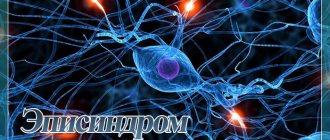Status epilepticus is a condition characterized by frequently recurring or continuous epileptic seizures lasting up to half an hour.
Moreover, each new seizure occurs earlier than the patient manages to recover from the previous one. During the time between attacks, consciousness remains unclear, and signs of coma persist, which are characterized by impaired blood flow through the vessels and respiratory dysfunction.
Epistatus is the most common neurological condition. The incidence of this pathology is approximately 20 cases per 100,000 people.
In half of the cases, ES occurs in young children. Among people suffering from epilepsy, this condition is more common in children than in adults (in a ratio of 15-25% to 5%).
About 7% of patients with epilepsy have a history of one to three epilepsy attacks throughout their illness.
What is the provoking factor?
The main reason for the occurrence of epileptic seizures is the withdrawal of medications taken, the action of which is aimed at suppressing epileptic seizures.
However, status epilepticus can occur not only against the background of epilepsy, but also due to brain lesions, including:
- head injury;
- intoxication;
- intracranial malignant tumor;
- circulatory disorders in the brain;
- infection;
- dropsy of the brain (encephalopathy);
- withdrawal syndrome;
- complications of diabetes;
- hematoma.
The incidence of epistatus without a predisposing factor - epilepsy is approximately 50%.
When to call an ambulance?
- if the attack occurred in a pregnant woman;
- if the attack occurred in a child or elderly person;
- if the attack lasted more than 5 minutes;
- if the patient was injured during an attack;
- if after an attack the patient does not regain consciousness for more than 10 minutes;
- if this is the first attack;
- if there is evidence of diabetes mellitus, infection, poisoning, high body temperature;
- if an epileptic attack occurred in water;
- the next attack occurred immediately after the previous one (serial attacks);
- regaining consciousness after an attack is slow, confusion is noted;
- if the patient has breathing problems.
Most attacks end on their own and last only briefly (a few seconds or minutes). In these cases (except for the first episode), there is no need to call a doctor, carry out special treatment or hospitalize the patient.
However, a prolonged attack poses a threat to the development of status epilepticus and can be dangerous for the patient. In these cases, intramuscular or intravenous administration of drugs is required to stop the attack.
Generalized attacks usually stop spontaneously after 1-3 minutes, and therefore the patient usually does not need the help of a doctor. However, if the duration of the attack exceeds 5 minutes, special measures are needed to stop the attack. As a rule, in these cases, intramuscular or intravenous administration of drugs leads to the cessation of the attack.
Some medications used to relieve an attack are also available in dosage forms for rectal administration (microenemas in rectal tubes, as well as suppositories). These forms are easy to use, and parents or relatives of the patient can administer the drug themselves without calling a doctor or waiting for an ambulance to arrive.
In case of prolonged attacks, or attacks following one after another without restoration of consciousness, there is a risk of developing status epilepticus, and the patient should be hospitalized in the intensive care unit.
Focal attacks also require medical intervention only if the attack is prolonged.
Types and stages of epistatus
The variability of the types of epileptic seizures determines the formation of various clinical forms of epileptic seizures. They are divided into two main groups - convulsive and non-convulsive seizures.
According to the classification, the following types of status epilepticus are distinguished:
- Generalized
SE - characterized by widespread tonic-clonic convulsions with an unconscious state. - Not completely generalized
ES - characterized by atypical muscle spasms with complete loss of consciousness. Tonic status is most common among children with Lennox-Gastaut syndrome. Can be observed at different ages. Clonic status is observed with epilepsy in infants, as well as with convulsions with high fever in young children. Myoclonic status is characterized by constant or episodic muscle twitching. - The status of focal paroxysms
proceeds according to the type of Jacksonian epilepsy with muscle contraction of a certain localization, for example, only the muscles of the face, one limb or half of the body. In this case, loss of consciousness may not occur. - Absence or non-convulsive status
is accompanied by a complete loss of consciousness without muscle contractions. Such attacks are characterized by the mildest course, however, due to the absence of seizures, diagnosis can be difficult. - Partial status
is characterized by unconscious and automatic actions with complete or incomplete loss of consciousness.
The stages of development of epistatus are also distinguished:
- pre-status
- lasts 1-10 minutes; - initial
- lasts from 10 minutes to half an hour; - expanded
- lasts from half an hour to an hour; - refractory
- lasts more than an hour.
Causes of epilepsy
Epilepsy is an umbrella term for a group of conditions that involve abnormal electrical activity in the brain.
A common cause of seizures is chronic alcoholism. The more often a patient drinks alcohol and the higher the dosage, the greater the risk that alcohol dependence will manifest itself in the form of epileptic psychosis. The quality of alcoholic beverages also affects the dynamics of the disease. The lower the grade of alcohol, the more harmful toxic impurities it contains, and the worse its effect on human health. about the effect of alcohol on the patient’s brain, which manifests itself in the form of Wernicke-Korsakoff syndrome .
Many people with epilepsy have no explanation for their condition other than alcoholism. This is called idiopathic epilepsy.
Idiopathic epilepsy does not show any visible brain damage that might explain why symptoms occur. Heredity plays an important role in this type of epilepsy. The prospects for idiopathic epilepsy are relatively good and after successful treatment of alcoholism the patient can be free of seizures.
What does it look like in real life
Symptoms of status epilepticus are determined by severe disorders in consciousness, respiratory system and hemodynamics, which are caused by a previous attack; the number of seizures during epileptic status can range from 3 to 20 per hour.
Consciousness by the time of the next attack does not clear up and the person is in a state of stupor, numbness or coma.
With prolonged ES, the comatose state worsens, becomes deeper, convulsions take on a tonic form, an increase in blood pressure is replaced by a sharp decrease, and increased reflexion is replaced by a lack of reactions. Hemodynamic and respiratory disorders become more pronounced.
The convulsions may disappear, and then the stage of epileptic prostration begins, which is characterized by external changes:
- pupil size changes;
- the gaze becomes unconscious;
- mouth slightly open.
It is very dangerous!
In this condition, death can occur. Epistatus necessarily lasts more than half an hour. This condition should be differentiated from episodic attacks, during the intervals between which there is a complete or almost complete clearing of consciousness, as well as a partial restoration of the patient’s physiological state.
The course of convulsive SE can be divided into two phases. At the first stage, compensatory changes occur to maintain blood circulation and the metabolic process.
This condition is characterized by:
- tachycardia;
- high blood pressure;
- vomit;
- involuntary urination;
- involuntary defecation.
The second phase occurs after half an hour or an hour and is characterized by a breakdown of compensatory changes. In this state, the following processes occur:
- lowering blood pressure;
- arrhythmia;
- respiratory dysfunction;
- thrombosis of the pulmonary artery and its branches;
- acute renal and liver failure.
Non-convulsive epistatus is characterized by various disorders of consciousness:
- feeling of detachment;
- immobilization.
In the case of ES of complex partial seizures, the following is observed:
- behavioral deviations;
- confusion;
- symptoms of psychosis.
Status epilepticus from A to Z:
Why does a seizure occur?
According to scientists, an epileptic seizure begins due to abnormal activity of nerve cells in the brain. A powerful electrical discharge occurs, which becomes a trigger. The patient suddenly begins to have strong and uncontrollable convulsions.
In historical sources, epilepsy is called a “falling disease” because the patient falls off his feet. Historians claim that many celebrities of past centuries suffered from similar attacks, such as Napoleon and Julius Caesar. The disease usually develops in childhood and adolescence. Over time, the interval between attacks and the nature of the seizures may change noticeably.
First aid - rules and tips
The main goal when providing first emergency care in case of epistatus before the arrival of doctors is to prevent damage and trauma to the patient.
What to do during an attack:
- lay the person on a comfortable surface to reduce the risk of injury;
- remove those items of clothing that may cause discomfort (for example, a tie, a belt), unbutton the collar;
- place rolled clothing under your head;
- carefully turn your head to the side so that the patient does not choke on his saliva;
- if your mouth is slightly open, you need to put a handkerchief or some kind of cloth between your teeth, but in no case a sharp object, so as not to break your teeth;
- remove all dangerous objects that are in the immediate vicinity to avoid injury;
- do not hold the person too tightly, otherwise there is a high risk of broken bones;
- do not open your teeth if they are clenched.
What not to do during an attack:
- Hold the trembling limbs with force. This can lead to fractures and dislocations if too much force is applied.
- Unclench clenched jaws with force or hard objects. This should not be done even if you bite your tongue, even if it begins to bleed!
- Water the patient with water.
- Give water and tablets to drink during an attack.
- Perform artificial respiration or cardiac massage.
After an attack, try to wake the patient by shaking him, tapping him, letting him smell pungent odors, or using any other methods.
Further actions
Relief of status epilepticus is carried out through the following measures:
- ensuring airway patency;
- use of oxygen therapy;
- intravenous injection of Diazepam (maximum daily dose - 40 mg), a side effect of this drug may be respiratory depression.
Further therapy is carried out by administering medications depending on the stage of status epilepticus.
At the initial stage, the following drugs are used to relieve status epilepticus:
- Diazepam;
- Lorazepam;
- Depakine;
- Feniton;
- Oxybutyrate.
Among the side effects of treatment, the following consequences can be identified: arterial hypotension, acute toxic hepatitis, phlebosclerosis, hypokalemia.
At the advanced stage of ES the following is used:
- Diazepam;
- Lorazepam;
- Phenobarbital;
- Sodium thiopental.
At the refractory stage of ES, the following measures are carried out:
- Intubation, correction of electrolyte disturbances, transfer to artificial ventilation of the lungs
- to maintain vital functions of the body. - Barbiturate anesthesia
- intravenous injection of sodium thiopental for 20 seconds. 100-250 mg of the drug is administered. If the patient's condition does not improve, a dose of 50 mg is administered every few minutes until the seizure stops. Barbiturate anesthesia can last from 12 hours to a day. - Dexamethasone and Mannitol injections
are given to prevent cerebral edema. - Infusion dehydration therapy
is carried out to eliminate disorders of liquor dynamics and the metabolic process. For this purpose the following are used: Magenzia, Lasix, Cordiamin, Eufillin, Korglykon.
In the event that the epistatus is symptomatic, that is, it arose against the background of brain damage, a neurosurgical operation should be performed to compress the brain vessels.
Features of the condition in children
Very often, epistatus that occurs in children is a sign of the onset of epilepsy, but it happens that convulsive attacks appear already in the later stages of the course of this disease.
In newborns, a seizure occurs with partial loss of consciousness, while the reaction to external stimuli remains intact.
Generalized SE can manifest itself as tonic-clonic, clonic, myoclonic convulsions.
In nonconvulsive SE, electroencephalography is used to detect peak-wave stupor and slow waves, which reflect a state of epileptic stupefaction. Partial ES can be simple, somatomotor, or dysphasic.
In complex partial epistatus, stable preservation of epileptic twilight of consciousness is observed.
With generalized SE, the main property of an epileptic seizure is disrupted - it does not go away on its own.
The number of attacks can reach several tens or even hundreds per day. In this case, respiratory function and hemodynamics are disrupted, metabolic processes in the brain are disrupted, and the coma state can deepen until death occurs.
Treatment
At the Neurology Clinic of the Yusupov Hospital, clients can count on several treatment methods. In particular, we are talking about drug therapy and neurosurgical technologies. By skillfully combining these techniques, doctors achieve a significant improvement in the condition of their patients and provide them with the most comfortable life possible with this pathology.
It should be understood that epilepsy is not a death sentence; people with this disease can live a normal life, limiting themselves to virtually nothing. To do this, you need to regularly undergo the necessary examinations, see your doctor and take prescribed medications. Doctors at the Yusupov Hospital take care of their patients, regularly ordering examinations and prescribing medications only based on the individual indicators of each patient.
Danger of condition
Mortality in the case of status epilepticus with previously diagnosed epilepsy is 5%, in the case of symptomatic status - 30-50%. If the ES continues for more than an hour, the following serious consequences may occur:
- cerebral edema;
- oxygen starvation of the brain;
- excessive decrease in blood pressure;
- lactic acidosis - excessive accumulation of lactic acid in the body;
- electrolyte imbalance;
- mental retardation and mental retardation in children.
Non-convulsive SE is less dangerous than generalized SE, however, in this case, cognitive impairment may develop.
Types of epileptic seizures
- Generalized seizures have warning signs. They can appear several days or a couple of hours before the attack. The next attack is heralded by sudden changes in behavior, increased excitability, irritability and eating disorders. Before an attack, a certain “aura” is recorded in people:
- Sensory aura - the patient is tormented by hallucinations, imaginary visual images and sounds.
- Psychic aura is the gratuitous experience of strong emotions. May be overcome by a state of horror or inexplicable happiness.
- Vegetative aura is a disruption of the functioning of internal organs. Painful sensations, nausea, rapid heartbeat, etc. appear.
- Motor aura - a person performs strange movements with his arms and legs, characteristically throws his head back, etc.
- Speech aura - incoherent speech, uttering meaningless words and sounds.
- Sensitive aura - numbness of individual parts of the body, chills, etc.
When an epileptic attack occurs, the patient may scream or wheeze. He turns pale, loses consciousness and falls to the ground. His breathing slows. Then the patient’s body tenses, and the limbs begin to twitch involuntarily. The pupils dilate, blood pressure rises, saliva flows from the mouth, sweating increases and the face becomes flushed with blood. In some cases, uncontrolled emptying of the body occurs. During an attack, the patient may bite his tongue. After some time, the convulsions subside and the person comes to his senses. On average, a generalized seizure can last from a few seconds to several minutes.
- Focal seizures are directed at only one part of the body and can move from one area to another. After such attacks, you must definitely visit a doctor, since organic brain damage occurs.
- There is a type of epileptic seizure that is characterized by petit mal seizures. The man loses consciousness, but does not fall. The face becomes pale, and the facial muscles begin to twitch convulsively. The gaze is fixed on one point. Speech becomes meaningless and incoherent.
- With temporal lobe epilepsy, polymorphic paroxysms occur. Their harbinger is the vegetative aura. A person commits inappropriate actions and can harm others.
In fact, there are about 30 types of seizures with a wide range of characteristic symptoms. Entire volumes of scientific literature are devoted to this topic.








